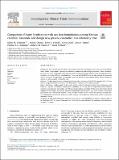| dc.contributor.author | Emily M Teshome, Walter Otieno, Sofie R Terwel, Victor Osoti, Ayşe Y Demir, Pauline EA Andango, Andrew M Prentice, Hans Verhoef | |
| dc.date.accessioned | 2020-08-14T08:05:53Z | |
| dc.date.available | 2020-08-14T08:05:53Z | |
| dc.date.issued | 2017-09-01 | |
| dc.identifier.uri | https://repository.maseno.ac.ke/handle/123456789/2115 | |
| dc.description.abstract | Introduction
Home fortification powders containing iron and other micronutrients have been recommended by World Health Organisation to prevent iron deficiency anaemia in areas of high prevalence. There is evidence, however, that home fortification at this iron dose may cause gastrointestinal adverse events including diarrhoea. Providing a low dose of highly absorbable iron (3 mg iron as NaFeEDTA) may be safer because the decreased amount of iron in the gut lumen can possibly reduce the burden of these adverse effects whilst resulting in similar or higher amounts of absorbed iron.
Objective
To show non-inferiority of home fortification with 3 mg iron as NaFeEDTA compared with 12.5 mg iron as encapsulated ferrous fumarate, with haemoglobin response as the primary outcome.
Design
338 Kenyan children aged 12–36 months will be randomly allocated to daily home fortification with either: a) 3 mg iron as … | en_US |
| dc.publisher | Elsevier | en_US |
| dc.subject | Adherence, Anaemia, Child, Preschool, Dietary supplements, Iron, Non-inferiority Fortification | en_US |
| dc.title | Comparison of home fortification with two iron formulations among Kenyan children: Rationale and design of a placebo-controlled non-inferiority trial | en_US |
| dc.type | Article | en_US |

